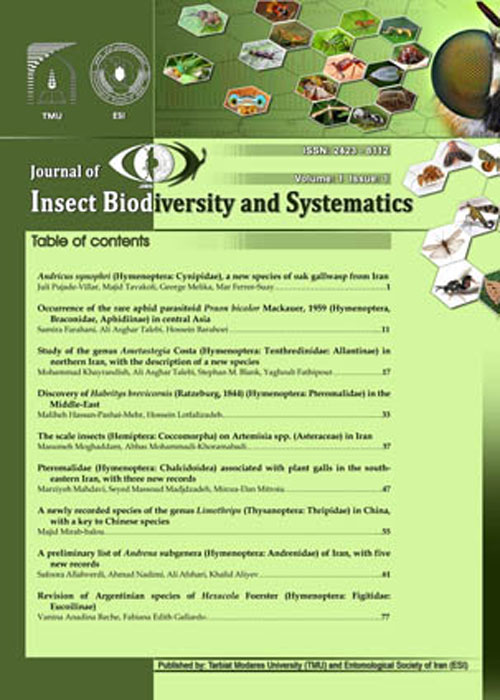فهرست مطالب

Journal of Insect Biodiversity and Systematics
Volume:4 Issue: 1, Mar 2018
- تاریخ انتشار: 1396/11/30
- تعداد عناوین: 7
-
-
Pages 1-11The present study is based on the material collected from Alborz and Guilan provinces of Iran during March to November 2010 and 2011. Three species of the genus Platylabus Wesmael were collected and identified, of which Platylabus orbitalis (Gravenhorst, 1829) (Hym.: Ichneumonidae: Ichneumoninae, Platylabini) is newly recorded from Iran and the Middle East region. This study increases the number of known Iranian species of the tribe Platylabini and genus Platylabus to 12 and 5 species, respectively. An identification key to Iranian Platylabus, as well as a brief description and diagnostic characters of the new record species is provided.Keywords: Ichneumonidae, Platylabini, Platylabus, new record, taxonomy
-
Pages 13-23This contribution reports 15 species of Encyrtidae (Hymenoptera: Chalcidoidea) belonging to 12 genera from Khuzestan province of Iran of which 11 species were determined to species level. Five genera and seven species are new for the fauna of Khuzestan province. Three genera viz. Apoleptomastix, Rhopus and Thomsonisca, and three species viz. Apoleptomastix bicoloricornis (Girault, 1915), Leptomastidea bifasciata (Mayr, 1876) and Rhopus nigroclavatus (Ashmead, 1902) are new for the Iranian fauna.Keywords: fauna, Iran, Khuzestan, Encyrtidae, new records
-
Pages 25-29During the collecting of Hypogastruridae (Collembola) in Mazandaran province, Xenylla mediterranea da Gama, 1964 was reported for the first time from Iran. With the new record in this study, the number of Xynella species known from Iran increased to four. Information for specie including material examined, description, ecology, distribution, and illustrations are given.Keywords: Xenylla mediterranea, Hypogastruridae, Collembola, Iran, new record
-
Pages 31-35Israelius carthami Richards, 1952 was recorded for the first time from Iran, based on reared specimens from three Asteraceae capitulum: Cirsium congestum Fisch. & C.A.Mey., Carthamus lanatus L. and Xeranthemums quarrosum Boiss. In our rearing, a fruit fly species [Terellia nigripalpis Hendel (Diptera: Tephritidae)] was obtained on C. congestum. All host-plant associations are newly established to the science. General distribution of this parasitoid and their biological associations were discussed.Keywords: Host, distribution, new record, Chrysidoidea, Sclerodermini
-
Pages 37-45Three Phyllonorycter species namely, Ph. coryli (Nicelli, 1851), Ph. millierella (Staudinger, 1871) and Ph. roboris (Zeller, 1839) are newly reported for the fauna of Iran. These species are collected in Azarbaijan-e Sharghi, Tehran and Kordestan provinces, respectively. The first two species were collected as larvae while feeding on Carpinus betulus L. (Betulaceae) and Celtis australis L. (Cannabaceae), in the order, and the last one collected as adult in an Oak forest using light trap. The genus Carpinus L. and C. betulus are newly reported as larval host plant for Ph. coryli. Brief taxonomic characterizations of these species are provided and an updated list of the Phyllonorycter species occurring in Iran is presented.Keywords: Gracillariidae, Phyllonorycter, new record, new host plant, Iran
-
Pages 47-55The objective of this study was to identify the species of thrips associated with rice crops in order to determine population fluctuation of the dominant species. Studies were conducted during the month of April to August in the year 2017 form different growth stages of rice in Babolsar city, Mazandaran Province (Northern Iran). Samplings were done from four fields located at two sites, KeyxaMahalle and MirBazar. A total of seven species of thrips belonging to four genera and two families (Thripidae and Phlaeothripidae) were identified. Amongst them, Haplothrips eragrostidis Priesner was the dominant species accounting for 75.47% in abundance. This was followed by Thrips hawaiiensis Morgan comprising 6.47%. The other species include Anaphothrips sudanensis Trybom, Frankliniella intonsa (Trybom), F. tenuicornis (Uzel), Thrips tabaci Lindeman and Haplothrips flavicinctus (Karny) which comprised of4.85%, 4.32%, 4.31%, 4.04% and 0.54% respectively. The maximum number of thrips species was found in the middle of July and minimum in the month of May. Assessment of thrips abundance in rice fields were started at the beginning of dough stage and were continued until complete maturity.Keywords: Rice, Haplothrips eragrostidis, abundance, phenology, Iran
-
Parasitic and phoretic mites (Arachnida, Acari) reported from insects (Arthropoda: Insecta) in EgyptPages 57-71
Mites exploit various symbiotic associations with insects and other arthropods, mainly parasitism and phoresy. Faunistic information of parasitic and phoretic mites on insects in Egypt is reviewed. Previous published records are gathered and, in some cases, altered. This paper presents an annotated list of the 120 species, including unidentified spp., of mites extracted from insects in Egypt to date. Mite species belong to 42 families [16 of Mesostigmata, 19 of Prostigmata, five of Astigmata and two in Cryptostigmata (Oribatida)]. Information about insect hosts, attachment sites and geographic distribution is provided.
Keywords: mites, Acari, Insecta, phoresy, parasitism, Egypt

